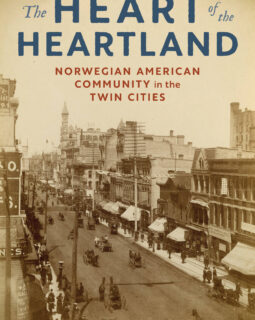The Heart of the Heartland: Norwegian American Community in the Twin Cities

- Year
- 2024
- Creators
- Reviewed by Mary Lethert Wingerd
- Topics
The Heart of the Heartland: Norwegian American Community in the Twin Cities
David C. Mauk
St. Paul, MN: Minnesota Historical Society Press, 2022
472 pages; paperback, B&W illustrations, 7 maps, $29.95
As the title of this volume suggests, the Twin Cities, especially Minneapolis, have long claimed the title as the heart of Norwegian settlement in America. Even today, generations beyond the peak exodus from Norway, Minnesota is renowned as an ethnic Scandinavian stronghold, though in reality that distinction is increasingly difficult to detect in its present-day multiethnic population.
Still, as David C. Mauk compellingly demonstrates in this densely researched tome, Norwegian immigrants and generations of their descendants played essential roles in the settlement and development of the Twin Cities and the social/cultural ethos that came to distinguish them. The author offers a tour de force of research, mining every available source to find evidence of Norwegian influence from the outset of white settlement to the present.
Scholars of immigration and ethnicity will find much to appreciate in the level of detail presented here. Such a fine-grained examination of a particular community is invaluable in bringing to light larger patterns of immigrant settlement and acculturation. For example, Mauk traces a little-studied phenomenon of rural-to-urban ethnic chain migration that greatly influenced community development in the Twin Cities. In fact, the greatest growth in the Norwegian community there came well after direct immigration from Norway had slowed. Minneapolis and Saint Paul acted as magnets that drew Norwegians who had first settled in rural Minnesota. They came to the cities with a store of American experience, which enhanced their ability to navigate the urban environment and advance the success of the ethnic group as a whole. This insight and others to be gleaned from this study have broad implications for immigration studies.
One could wish, though, for more information about conditions in Norway that prompted, and then ended, such a significant exodus. Who were these people? What were the political and economic conditions that caused them to pull up stakes in the first place and undertake such a life-changing journey?
Experiences in the home country clearly factored into the way the community grew and developed in Minnesota, as well as its complicated relationship with Swedish and Danish fellow ethnic Americans, and continued attachment to Norway itself. Though we learn here that generations of Norwegian Americans maintained a strong connection to their historic homeland, somewhat more attention to the initial push factors would have enriched an understanding of the evolving social and cultural landscape.
Nonetheless, historians will value the breadth and depth of information in this volume. The general interested reader, however, may find the level of detail daunting. The fascinating story of the Norwegian-American community often gets lost in a plethora of facts that do little to advance the narrative. It seems unnecessary to know the hour-by-hour schedule of events for every Norwegian celebration or to know the name of every person who headed one of the Norwegian congregations or organizations. And it is impossible to follow the intricate descriptions of neighborhood and ward configurations without a map to function as a guide.
None of this, however, should deter those with a serious interest in the Norwegian-American experience in America. Nor should it detract from the contributions to immigration scholarship made by this volume, which represents a prodigious accomplishment, clearly the result of years of dedicated research by an expert on this subject. There is much to be learned from this authoritative history of the “heart of the heartland,” a welcome addition to Minnesota history and to the broad canvas of immigration history as well.
Mary Lethert Wingerd is professor emerita of history at St. Cloud State University. She is the author of Claiming the City: Politics, Faith, and the Power of Place in St. Paul and North Country: The Making of Minnesota.
This review originally published in the journal Norwegian-American Studies 41. Copyright 2023 Norwegian-American Historical Association. It is reprinted here with permission from the Norwegian-American Historical Association and the University of Minnesota Press.
- Year
- 2024
- Creators
- Reviewed by Mary Lethert Wingerd
- Topics